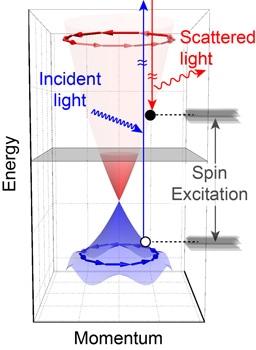Oct 3 2017
Imagine two schools of fish that swim in circles in clockwise and counterclockwise directions. It will be highly confusing. At present, Researchers from Rutgers University-New Brunswick as well as the University of Florida have found out the “chiral spin mode,” that is, oceans of electrons spinning in circles of opposite directions.
 The blue and red cones show the energy and momentum of surface electrons in a 3D topological insulator. The spin structure is shown in the blue and red arrows at the top and bottom, respectively. Light promotes electrons from the blue cone into the red cone, with the spin direction flipping. The orderly spinning leads to the chiral spin mode observed in this study. CREDIT: Hsiang-Hsi (Sean) Kung/Rutgers University-New Brunswick.
The blue and red cones show the energy and momentum of surface electrons in a 3D topological insulator. The spin structure is shown in the blue and red arrows at the top and bottom, respectively. Light promotes electrons from the blue cone into the red cone, with the spin direction flipping. The orderly spinning leads to the chiral spin mode observed in this study. CREDIT: Hsiang-Hsi (Sean) Kung/Rutgers University-New Brunswick.
We discovered a new collective spin mode that can be used to transport energy or information with very little energy dissipation, and it can be a platform for building novel electronic devices such as computers and processors.
Girsh Blumberg, Senior Author of the research and Professor, the Department of Physics and Astronomy, the School of Arts and Sciences, Rutgers
Collective modes of chiral spin are traveling waves of electron spins without any charge current but with the ability to alter the “spinning” directions of electrons. Here, “chiral” means entities—similar to one’s left and right hands—matched with one another but asymmetrical and which cannot be overlapped onto their mirror image.
The research was headed by Hsiang-Hsi (Sean) Kung, a Graduate Student at Blumberg’s Rutgers Laser Spectroscopy Lab, and has been published in the journal Physical Review Letters. Kung applied a tailor-made, ultra-sensitive spectrometer to investigate a prototypical 3D topological insulator. Saurabh Maiti and Professor Dmitrii Maslov from the University of Florida designed a microscopic theoretical model with the ability to predict the temperature and energy evolution of the chiral spin mode, confirming the experimental observation.
Electrons behave like simple, monotonous elementary particles in vacuum. However, in the case of solids, the aggregated behavior of numerous electrons interacting with one another and the fundamental platform might give rise to various circumstances culminating in innovative applications in magnetism, superconductivity and piezoelectricity (voltage produced by placing materials under pressure), among others. The aim of condensed matter science—dealing with liquids, solids and other condense forms of matter — is to unearth innovative phenomena in new materials.
Silicon-based electronics (e.g. computer chips and computers) are the most significant creations of humans. However, the use of silicon results in substantial loss in energy during scale down. A substitutive idea is to tap the electron spins to convey information in exceptionally thin wires, which is theoretically proposed to cut down loss in energy.
The recently found “chiral spin mode” arises from the oceans of electrons present on the surface of “3D topological insulators.” The insulating, nonmagnetic material in these distinctive insulators has robust metallic surfaces such that the electrons are trapped and are free to move only on 2D surfaces.
Specifically, the spinning axes of the electrons are aligned and are perpendicular to their velocity. Chiral spin modes naturally crop up out of the surface of these insulating materials. However, they could not be observed earlier owing to the defects in crystals. The experimental observation in this research could be achieved by developing ultra-clean crystals by Xueyun Wang, a Rutgers Doctoral Student and Sang-Wook Cheong, Board of Governors Professor, at the Rutgers Center for Emergent Materials.
The findings of the study open the door for developing futuristic low-loss electronic devices. The National Science Foundation funded the Rutgers research.